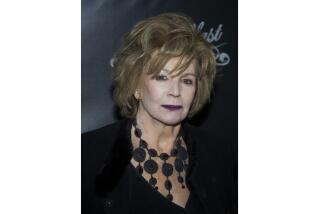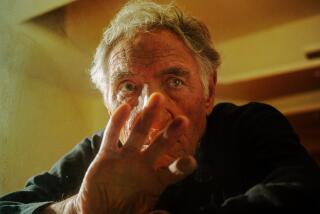A straight shooter
Hugh O’Brian made a career of playing ruggedly serious heroic types, most notably as the stalwart lawman in the western saga “The Life and Times of Wyatt Earp,” which aired on ABC from 1955 to 1961.
So it comes a bit of surprise to learn the former Marine drill instructor is kind of a hoot -- the title of the autobiography he’s writing is “The Older I Get, the Better I Was, or Fate Is a Four-Letter Word.”
He tells you he’s 84 -- though some sources say he’s 86 -- and he “wants more.” When he finally married his longtime girlfriend, the former Virginia Barber, three years ago, the two tied the knot at Forest Lawn Memorial Park in Glendale in what was described as “the wedding to die for.”
That quirkiness is in evidence in his rustic and airy Benedict Canyon home -- on the floor in one room is a huge Bernese mountain dog stuffed animal; a stuffed gorilla is relaxing on a chair in the living room.
Of course, these rooms are also filled with memorabilia from his acting profession including his trademark Earp hat, as well as items relating to Hugh O’Brian Youth Leadership (HOBY), which he founded in 1958 after spending time with Dr. Albert Schweitzer in Africa.
“There was a wonderful man named Norman Cousins who was at that time the head of the Saturday Review of Literature,” O’Brian says over a lunch of salad and gazpacho fixed by his wife, whom he refers to as his “life.” Sporting a beard, O’Brian’s a tad heavier than his “Earp” days, but seems to be in fine form.
“I met him [Cousins] at a function at UCLA. There was a reception line for subscribers to meet Norman and he was coming down the receiving line and looked at me and said, ‘Wyatt Earp, you read the Saturday Review of Literature? Wyatt, do you ever get to New York? Next time you’re there we’ll have lunch.’ ”
O’Brian looked up Cousins on his next visit to New York. Over lunch, the actor commented on Cousins’ recent article about Schweitzer’s clinic in Africa and how much he wanted to meet him. A few weeks later, O’Brian received a note from the legendary doctor saying he would be welcomed any time.
“I spent some good time there at this clinic,” O’Brian says. “During the day I helped build baby cribs, pass out food and then in the afternoon we’d go upstream where the leper colony was. I had anywhere from two to 3 1/2 hours with him every night in his little hut. He had such a passion for youth . . . and thought nothing had been done to try to reach young people and help develop positive attitudes and build leaders for the future.”
O’Brian decided to change that. Arriving home, “I had several ideas and thoughts about what we could do to enhance, help focus and develop future leaders.”
Over the past five decades, about 400,000 10th graders have attended HOBY programs throughout the country. O’Brian states that some 50 HOBY alumni are working on Capitol Hill at any given time.
O’Brian started in films in 1949’s “Not Wanted,” directed by Ida Lupino. Signed to Universal and Fox, he appeared in such films as “Red Ball Express” and “Broken Lance” before becoming Earp. He’s also been featured in such films as “Love Has Many Faces” and “Twins” and did guest spots in numerous TV series from “Perry Mason” to “Murder, She Wrote.”
Naturally, he’s a font of stories about old Hollywood, including his friendship with Marilyn Monroe, whom he befriended while making the 1954 film “There’s No Business Like Show Business.” The two later found themselves staying at the same hotel in Banff, Canada, while they were working on separate films.
“Almost every morning, Marilyn and I would grab a cup of coffee depending on who had to be on set first,” he says. “One morning, she looked like she had been hit by a truck.”
Monroe told him that every night some male fan would knock on her door hoping to get admittance to her room. She would tell him to go away, but the man wouldn’t.
“I said, ‘Let me try to handle it.’ So I took a 4-by-5-inch card and in fairly big print wrote, ‘Do not touch this door, otherwise, I am going to come to get you.’ She never had anybody knock again.”
It was O’Brian’s love for the ladies that led to him become an actor.
After World War II, he was living in the garage at the “House of Seven Garbos” on the Sunset Strip, so named because “a minimum of seven beautiful girls were living there at any given time.”
O’Brian was also dating an actress living at the boarding house who was doing a play in town. “If I wanted to see her, I had to go the rehearsals -- the second or third night of the rehearsals, the leading man didn’t show up,” he says.
So the director asked O’Brian to read the leading man’s role at the rehearsal.
“After about four days, they realized the guy wasn’t going to come back . . . so the director asked me if I would do the role.”
The director gave the novice a quick acting lesson. “First of all learn your lines; second, say them loud enough so they can hear you in the back row; and don’t bump into the furniture.”
The advice worked. “We did the show and a reporter from the L.A. Times came down to see it and the next day, he wrote a tremendous review. . . . That’s how I got started.”
--
Elsewhere
Arriving Tuesday on DVD is French director Jacques Demy’s underrated 1969 “Model Shop,” the only film he made in the United States. Gary Lockwood and Anouk Aimee star in this offbeat romance set in L.A.
--
More to Read
Sign up for our Book Club newsletter
Get the latest news, events and more from the Los Angeles Times Book Club, and help us get L.A. reading and talking.
You may occasionally receive promotional content from the Los Angeles Times.







